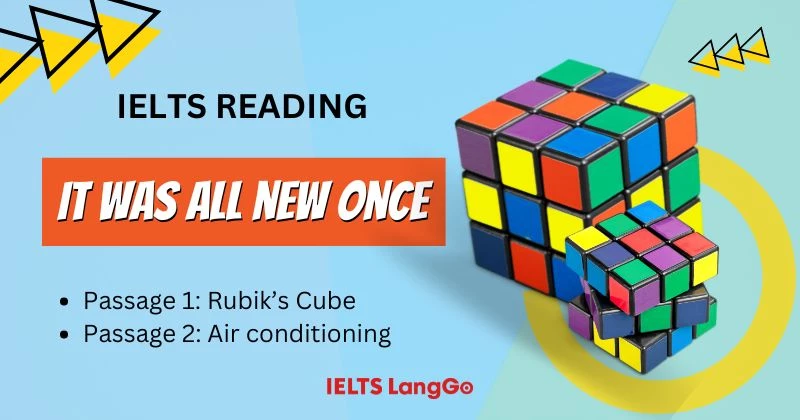


Trong phần luyện IELTS Reading hôm nay, chúng ta sẽ cùng ôn tập chủ đề It was all new once với 2 bài đọc rất hay là Rubik’s Cube - How the puzzle achieved success và Air conditioning
Các bạn hãy cùng làm đề để nâng cao kỹ năng làm các dạng bài IELTS Reading đồng thời trau dồi thêm nhiều kiến thức thú vị và hữu ích nhé!
Dưới đây là 2 bài đọc về chủ đề It was all new once và các câu hỏi luyện tập.
| Rubik’s Cube - How the puzzle achieved success Erno Rubik first studied sculpture and then later architecture in Budapest, where he went on to become a teacher of interior design. It was while he was working as a teacher that he began the preliminary work on an invention that he called the ‘Magic Cube'. Rubik was inspired by geometric puzzles such as the Chinese tangram, a puzzle consisting of various triangles, a square and a parallelogram which can be combined to create different shapes and figures. However, unlike the tangram, which is two- dimensional, Rubik was more interested in investigating how three-dimensional forms, such as the cube, could be moved and combined to produce other forms. His design consisted of a cube made up of layers of individual smaller cubes, and each smaller cube could be turned in any direction except diagonally. To ensure that the cubes could move independently, without falling apart, Rubik first attempted to join them together using elastic bands. However, this proved to be impossible, so Rubik then solved the problem by assembling them using a rounded interior. This permitted them to move smoothly and easily. He experimented with different ways of marking the smaller cubes, but ended up with the simple solution of giving a different colour to each side. The object was to twist the layers of small cubes so that each side of the large cube was an identical colour. Rubik took out a patent for the Cube in 1977 and started manufacturing it in the same year. The Cube came to the attention of a Hungarian businessman, Tibor Laczi, who then demonstrated it at the Nuremberg Toy Fair. When British toy expert Tom Kremer saw it, he thought it was amazing and he persuaded a manufacturer, Ideal Toys, to produce 1 million of them in 1979. Ideal Toys renamed the Cube after the toy’s inventor, and in 1980, Rubik’s Cube was shown at toy fairs all over the world. It won that year’s prize in Germany for Best Puzzle. Rubik’s Cube is believed to be the world’s best-selling puzzle; since its invention, more than 300 million Cubes have been sold worldwide. |
Questions 1-7
Choose NO MORE THAN TWO WORDS from the passage for each answer.
| Rubik’s Cube Originally named the 1. ………….., Rubik’s Cube consists of a number of smaller cubes organised in 2. ………….. The smaller cubes can be twisted in almost any way, though not 3. ………….. . The Cube’s 4. ………….. is shaped in a way that allows the smaller cubes to move smoothly. Each side of the smaller cubes has a different colour, and the aim of the puzzle is to organise the cubes so that the colours on the sides of the large cube are 5. ………….. . The manufacturers of the puzzle changed the name of the Cube to the name of its 6. ………….. it has now sold more than any other 7. ………….. in the world. |
| Air conditioning The history of an invention that makes life more pleasant Willis Carrier designed the first air-conditioning unit in 1902, just a year after graduating from Cornell University with a Masters in Engineering. At a Brooklyn printing plant, fluctuations in heat and moisture were causing the size of the printing paper to keep changing slightly, making it hard to align different colours. Carrier’s invention made it possible to control temperature and humidity levels and so align the colours. The invention also allowed industries such as film, processed food, textiles and pharmaceuticals to improve the quality of their products. In 1914, the first air-conditioning device was installed in a private house. However, its size, similar to that of an early computer, meant it took up too much space to come into widespread use, and later models, such as the Weathermaker, which Carrier brought out in the 1920s, cost too much for most people. Cooling for human comfort, rather than industrial need, really took off when three air conditioners were installed in the J.L. Hudson Department Store in Detroit, Michigan. People crowded into the shop to experience the new invention. The fashion spread from department stores to cinemas, whose income rose steeply as a result of the comfort they provided. To start with, money-conscious employers regarded air conditioning as a luxury. They considered that if they were paying people to work, they should not be paying for them to be comfortable as well. So in the 1940s and ’50s, the industry started putting out a different message about its product: according to their research, installing air conditioning increased productivity amongst employees. They found that typists increased their output by 24% when transferred from a regular office to a cooled one. Another study into office working conditions, which was carried out in the late ’50s, showed that the majority of companies cited air conditioning as the single most important contributor to efficiency in offices. However, air conditioning has its critics. Jed Brown, an environmentalist, complains that air conditioning is a factor in global warming. Unfortunately, he adds, because air conditioning leads to higher temperatures, people have to use it even more. However, he admits that it provides a healthier environment for many people in the heat of summer. |
Questions 1-5
Choose the correct letter, A, B, C or D.
1. When Willis Carrier invented air conditioning, his aim was to
A. make workers feel cooler.
B. produce more attractive paper.
C. set up a new business.
D. solve problems in a factory.
2. Home air conditioners were not popular at first because they were
A. too big and expensive.
B. not considered necessary.
C. too inefficient.
D. complicated to use.
3. Employers refused to put air conditioning in workplaces at first because they
A. could not afford to pay for it.
B. thought it was more suitable for cinemas.
C. did not want to spend money improving working conditions.
D. thought people would not work so hard in comfortable conditions.
4. What was the purpose of the research done in the 1940s and ’50s?
A. to make office workers produce more
B. to compare different types of air conditioner
C. to persuade businesses to buy air conditioners
D. to encourage employees to change offices
5. What does Jed Brown say about air conditioning?
A. In future, everyone will need it.
B. Turning it off will not reduce global warming.
C. It can seriously damage people’s health.
D. It is good for people, but bad for the environment.
Từ đề bài trên, các bạn có thể dễ dàng nhận ra 2 dạng bài vô cùng quen thuộc trong phần thi IELTS Reading là Gap Filling (Điền từ) và Multiple choice (Trắc nghiệm).
Để làm tốt 2 dạng bài này, các bạn hãy tham khảo ngay chiến thuật làm bài nhé:
Xem thêm:
Để kiểm tra xem các đáp án mình đưa ra đã chính xác chưa và nếu có sai thì sai ở đâu và tại sao thì các bạn hãy xem ngay phần đáp án kèm giải thích chi tiết dưới đây nhé.
1. Magic Cube
Dẫn chứng: "...he began the preliminary work on an invention that he called the 'Magic Cube'."
Giải thích: Erno Rubik đã đặt tên ban đầu cho phát minh của mình là 'Magic Cube' trước khi nó được đổi tên thành Rubik's Cube.
2. layers
Dẫn chứng: "His design consisted of a cube made up of layers of individual smaller cubes..."
Giải thích: Thiết kế của Rubik bao gồm một khối lập phương lớn được tạo thành từ các lớp (layers) của những khối lập phương nhỏ hơn.
3. diagonally
Dẫn chứng: "...and each smaller cube could be turned in any direction except diagonally."
Giải thích: Các khối lập phương nhỏ có thể xoay theo bất kỳ hướng nào ngoại trừ theo đường chéo (diagonally).
4. interior
Dẫn chứng: "...Rubik then solved the problem by assembling them using a rounded interior."
Giải thích: Phần bên trong (interior) của khối Rubik được thiết kế có dạng tròn để cho phép các khối nhỏ hơn di chuyển trơn tru.
5. identical
Dẫn chứng: "The object was to twist the layers of small cubes so that each side of the large cube was an identical colour."
Giải thích: Mục tiêu của trò chơi là xoay các lớp khối nhỏ sao cho mỗi mặt của khối lớn có màu giống nhau (identical).
6. inventor
Dẫn chứng: "Ideal Toys renamed the Cube after the toy's inventor..."
Giải thích: Hãng đồ chơi Ideal Toys đã đổi tên khối lập phương theo tên của người phát minh ra nó (inventor).
7. puzzle
Dẫn chứng: "Rubik's Cube is believed to be the world's best-selling puzzle; since its invention, more than 300 million Cubes have been sold worldwide."
Giải thích: Rubik's Cube được coi là trò giải đố (puzzle) bán chạy nhất thế giới với hơn 300 triệu khối đã được bán ra trên toàn cầu.
1. D
Dẫn chứng: "At a Brooklyn printing plant, fluctuations in heat and moisture were causing the size of the printing paper to keep changing slightly, making it hard to align different colours. Carrier's invention made it possible to control temperature and humidity levels and so align the colours."
Giải thích: Willis Carrier đã phát minh ra máy điều hòa không khí với mục đích giải quyết vấn đề cụ thể trong một nhà máy in ấn ở Brooklyn.
2. A
Dẫn chứng: "However, its size, similar to that of an early computer, meant it took up too much space to come into widespread use, and later models, such as the Weathermaker, which Carrier brought out in the 1920s, cost too much for most people."
Giải thích: Điều hòa không khí ban đầu không phổ biến trong các hộ gia đình vì chúng quá lớn (kích thước tương tự như máy tính đời đầu) và các mẫu sau này như Weathermaker thì quá đắt đỏ đối với hầu hết mọi người.
3. C
Dẫn chứng: "To start with, money-conscious employers regarded air conditioning as a luxury. They considered that if they were paying people to work, they should not be paying for them to be comfortable as well."
Giải thích: Ban đầu, các nhà tuyển dụng thận trọng về tài chính coi điều hòa không khí là một thứ xa xỉ. Họ cho rằng nếu họ đã trả tiền cho người lao động để làm việc, họ không nên trả thêm tiền để đảm bảo sự thoải mái cho người lao động, nghĩa là họ không muốn chi tiền để cải thiện điều kiện làm việc.
4. C
Dẫn chứng: "So in the 1940s and '50s, the industry started putting out a different message about its product: according to their research, installing air conditioning increased productivity amongst employees."
Giải thích: Mục đích của nghiên cứu được thực hiện vào những năm 1940 và 1950 là để thuyết phục các doanh nghiệp mua máy điều hòa không khí bằng cách đưa ra thông điệp khác về sản phẩm của họ, nhấn mạnh rằng việc lắp đặt điều hòa không khí làm tăng năng suất của nhân viên.
5. D
Dẫn chứng: "Jed Brown, an environmentalist, complains that air conditioning is a factor in global warming. Unfortunately, he adds, because air conditioning leads to higher temperatures, people have to use it even more. However, he admits that it provides a healthier environment for many people in the heat of summer."
Giải thích: Jed Brown, một nhà môi trường học, cho rằng điều hòa không khí là một yếu tố gây ra hiện tượng nóng lên toàn cầu (xấu cho môi trường), nhưng ông cũng thừa nhận rằng nó mang lại môi trường lành mạnh hơn cho nhiều người trong những ngày hè nóng bức (tốt cho con người).
Trên đây là phần luyện tập IELTS Reading: It was all new once với 2 bài đọc Rubik’s Cube - How the puzzle achieved success và Air conditioning kèm đáp án và giải thích chi tiết.
Làm đề thường xuyên là cách giúp bạn cải thiện kỹ năng làm bài IELTS Reading hiệu quả. Các bạn hãy luyện tập thật chăm chỉ để đạt band điểm thật cao nhé.



ĐẶT LỊCH TƯ VẤN MIỄN PHÍ LỘ TRÌNH Săn ƯU ĐÃI lên tới 12.000.000đ